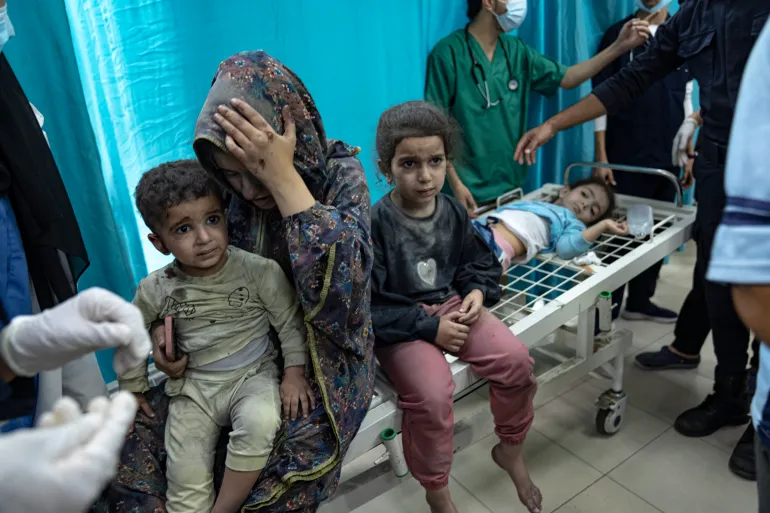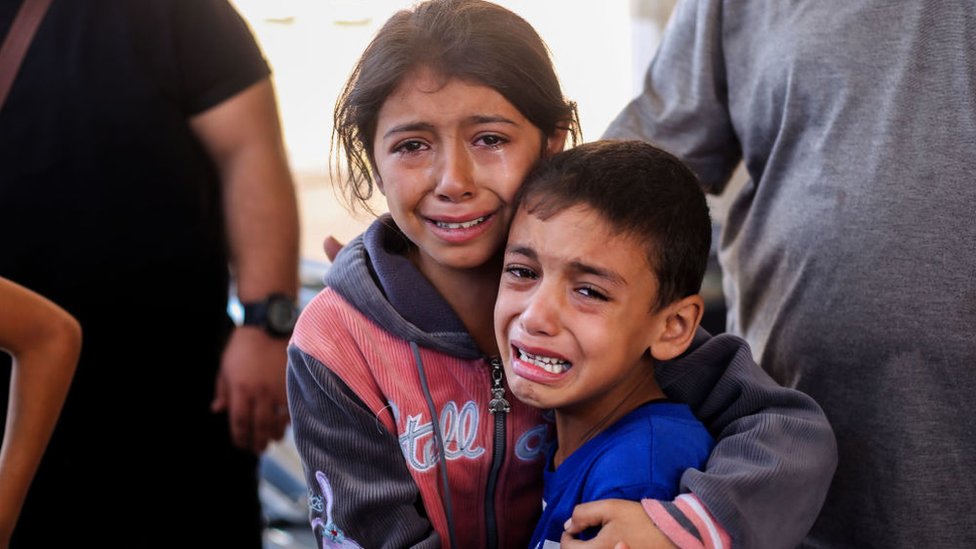All the hospitals in northern Gaza forced to shut down as Israeli forces continue to attack medical facilities. Newborn babies wrapped in blankets and lined up on a bed after being removed from incubators have become the defining image showing the Israeli siege of hospitals in the Gaza Strip. At least 32 patients, including six premature babies, have died at the al-Shifa Hospital in the last three days, Palestinian Health Ministry spokesperson Ashraf al-Qudra said Monday, as Gaza’s largest medical facility was forced to shut down due to lack of fuel and medicine. More than 100 bodies are decomposing inside the hospital, waiting to be buried.
“Regrettably, the hospital is not functioning as a hospital anymore. The world cannot stand silent while hospitals, which should be safe havens, are transformed into scenes of death, devastation, and despair,” said Tedros Adhanom Ghebreyesus, the director-general of the World Health Organization (WHO).
Israel imposed a total siege of the territory – home to 2.3 million people – banning fuel, food, electricity and water after launching its military offensive on October 7. Israeli action came in the wake of a Hamas attack that claimed more than 1,200 lives in Israel. All hospitals in northern Gaza are now “out of service”, as relentless Israeli air strikes have killed more than 11,000 people, most of them women and children, triggering global calls for a ceasefire. Here’s what we know about the challenges facing Gaza hospitals under Israeli occupation:

1. Healthcare crisis in Gaza:
Gaza Strip has been under siege for many years, with its healthcare system being one of the most severely affected. The ongoing conflict between Israel and Palestine has further exacerbated the situation, leading to a dire healthcare crisis in the region.
2. Severe shortage of essential supplies:
Hospitals in Gaza are grappling with a severe shortage of essential medical supplies and equipment due to the Israeli siege. This scarcity has hindered their ability to provide adequate healthcare to patients, resulting in a rising number of preventable deaths.
3. Power cuts and fuel shortages:
Gaza hospitals often face frequent power cuts due to limited access to electricity. This not only puts patients’ lives at risk but also affects the functionality of critical medical equipment such as ventilators and incubators. The scarcity of fuel exacerbates this problem, making it harder for hospitals to operate effectively.
4. Limited access to specialized care:
The siege has severely restricted the movement of medical professionals and patients, making it difficult for individuals with complex health conditions to seek specialized care elsewhere. This lack of access further strains the already overwhelmed healthcare system in Gaza, leading to avoidable fatalities.
5. High infant mortality rate:
The situation is particularly dire for newborns in Gaza. The restriction on medical supplies and specialized care has contributed to an alarming infant mortality rate. Babies who require neonatal intensive care often face insurmountable challenges due to the lack of necessary resources.
6. Psychological trauma and mental health support:
The prolonged siege and frequent episodes of violence have taken a toll on the mental health of Gaza’s residents. However, mental health support services are grossly inadequate due to limited resources and insufficient funding. The lack of attention to mental health exacerbates the overall healthcare crisis in the region.
7. International calls for urgent action:
Numerous global organizations and human rights advocates have spoken out against the dire situation in Gaza hospitals. They have called for immediate action to address the healthcare crisis, emphasizing the need for increased support and resources to save lives and alleviate sufferings.
8. Humanitarian aid efforts crucial:
In light of the ongoing crisis, there is an urgent need for increased humanitarian aid to be directed towards Gaza’s healthcare system. Providing essential medical supplies, equipment, and expertise can go a long way in saving lives and improving healthcare outcomes in the region.
9. A glimmer of hope:
Despite the challenges faced by Gaza’s hospitals, there have been stories of resilience and courage amid adversity. Local healthcare professionals and volunteers continue to work tirelessly to provide the best possible care under challenging circumstances, highlighting the indomitable spirit of Gaza’s medical community.
10. Long-term solutions needed:
While immediate humanitarian assistance is crucial, long-term solutions that address the root causes of the healthcare crisis in Gaza are vital. These include lifting the siege, ensuring free movement of medical professionals and patients, and promoting sustainable healthcare infrastructure development.
The situation in Gaza’s hospitals under Israeli siege is a dire one, with patients dying due to lack of essential resources and medical facilities being forced to close. This crisis has prompted global calls for a ceasefire and an end to the Israeli siege, as well as demands for accountability for the loss of innocent lives. The heartbreaking image of newborn babies being taken out of incubators serves as a powerful reminder of the devastating impact of the siege on Gaza’s most vulnerable population.














